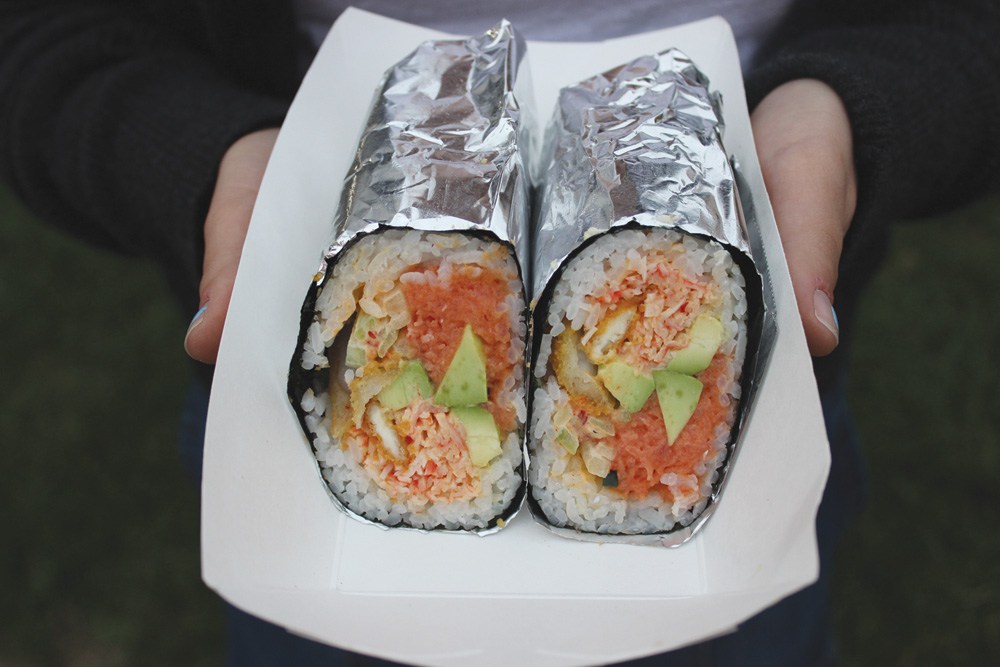The “I” Behind That’s How I Roll

That’s How I Roll, which can be located on North Campus or in Collegetown during the academic year, serves sushirittos — a hybrid of sushi and a burrito. (Karly Krasnow / Sun Staff Photographer)
By KAY XIAO
This story was first published on May 16 here.
Woepa Zegid reaches out of his truck to hand a customer her order before ducking back in and putting on a new pair of gloves. It’s dark outside, but the Tide orange truck emits a fluorescent glow. Zegid places a sheet of foil, a rectangular piece of seaweed and a flattened bed of sushi rice on a bamboo rolling mat. He then lays out the ingredients one after another — spicy tuna, salmon, fried cream cheese, avocado, lettuce, tempura flakes and drizzle of eel sauce — before rolling up the mat, pressing down on the top and sides and unraveling a burrito bundled warm and tight.
A native of Tibet, Zegid moved to New York City when he was 18 years old and has since worked various jobs in the restaurant industry. He washed dishes and waited tables and eventually started to work in the kitchen as an assistant chef at a Japanese restaurant. Zegid moved with his family to Ithaca and worked as head chef at Plum Tree for five years before leaving to start That’s How I Roll. The lower cost of rent and novelty of the sushirito, which has become popular in cities nationwide, inspired Zegid to order a food truck, devise a menu and go into business.
That’s How I Roll opened on North campus in April 2015, joining the ranks of mobile vendors like Collegetown Crêpes and Louie’s Lunch. At approximately 10 dollars a piece, its sushi burrito hybrids are filled with a generous assortment of ingredients that would typically go into a maki roll (rice, fish and vegetables in a seaweed wrap) and offer an on-the-go, relatively affordable alternative to the typical sushi dine-in experience. The sushiritos are the truck’s main attraction, but the vendor also serves a variety of hand rolls and snacks. Customer favorites include the Fire Cracker, which consists of small blocks of crunchy fried rice topped with spicy tuna and garnished with jalapeño, Sriracha, spicy mayo and the Spicy Tuna Nachos — Doritos with spicy tuna avocado and eel sauce dish that’s truly out of this world.
“It’s shockingly delicious for raw fish that comes out of a truck,” said Jessica Goldman ’16, a frequenter of the popular vendor who initially had some reservations about the safety and quality of ingredients. Zegid acknowledges the hesitancy of some customers regarding the freshness of his ingredients and identifies restocking ingredients daily as one of the main challenges to running a food truck that serves sushi-grade fish. “All of the ingredient have to be fresh, especially the fish, but also the avocado and the vegetables. It’s a trailer. It’s hard to fit everything in the truck, and when things run out we have to drive and grab fresh supplies,” he said.
Zegid’s dedication to the freshness of his ingredients matches the commitment he has to his customers and business. This is evidenced by the amount of time that he spends in the tiny space: Zegid begins prepping ingredients two hours before opening for business every day and spends seven days a week working at the truck during the academic year. “I guess I always want to work,” he said. “I like it.”
To read more dining stories, visit cornellsun.com.
